S-CAM BRAKE
ADJUSTMENT AND FUEL ECONOMY?
- GOAL:
- To understand the relationship between excessively tight S-CAM brakes and reduced fuel economy.
- OBJECTIVES:
- The student will:
- 1. Learn to properly identify an improperly adjusted S-CAM brake.
- 2. Understand how an excessively tight S-CAM brake can reduce fuel economy.
- 3. Demonstrate the correct procedures for adjusting an S-CAM brake.
- LESSON / INFORMATION:
- S-CAM brake systems have been used in medium and heavy trucks for decades. Many S-CAM brakes are non-self adjusting and therefore require periodic readjusting to compensate for brake shoe wear. The Figures below shows the comparison of non-self adjusting and self adjusting S-CAM brakes.
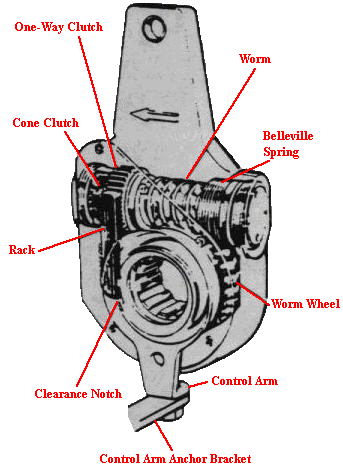
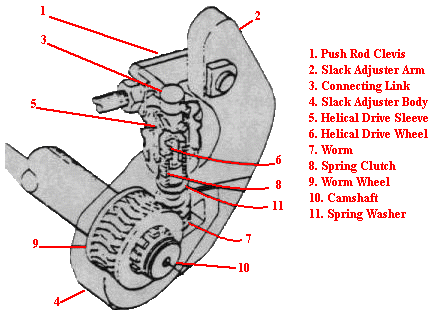
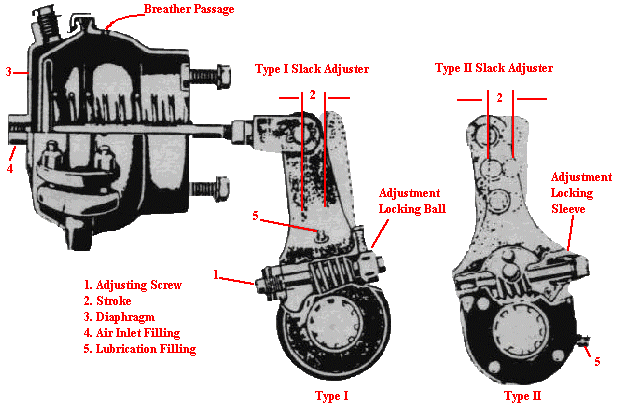
- Above Illustrations courtesy of Mack Trucks, Inc.
- An S-CAM brake with excessive shoe to drum clearance will engage too late while one which is too tight will engage too soon and may drag. This drag will reduce mpg and result in premature brake shoe and/or drum wear. It is critical for both safety and maximum fuel economy that S-CAM brakes be properly adjusted. It is important to note that all S-CAM brakes on a given vehicle be adjusted properly to avoid undue lateral forces or improper rear to front synchronization. Trailer brake adjustment on fifth wheel units is also important to synchronization and lateral force equalization. Figure 2 illustrates a typical S-CAM brake. The adjusting nut allows the shoe to be positioned closer or farther from the brake drum.
- WARNING:
- ALWAYS CONSULT THE MANUFACTURER'S SHOP MANUAL FOR EXACT S-CAM BRAKE ADJUSTMENT PROCEDURES.
- Figure 2
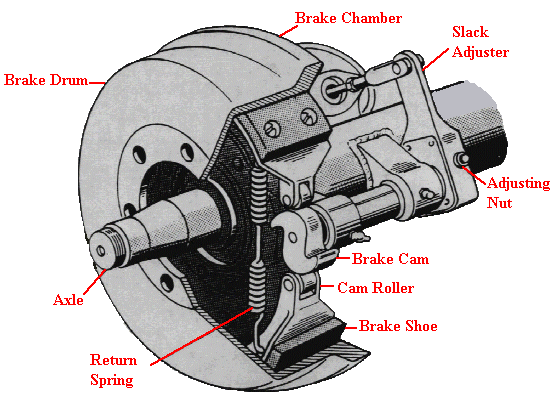
- Illustration courtesy of the Government of the Province of British Columbia.
- Besides an improperly set slack adjuster, two other abnormalities may cause an S-CAM brake to drag. A broken return spring or a return spring that has lost its tension will cause a brake shoe to drag. Also, excessive corrosion or lack of proper lubrication of the shoe mount and shoe to backing plate may also cause an S-CAM shoe to drag. Remember, a dragging shoe causes reduced mpg and premature shoe wear.
- ACTIVITY:
- WARNINGS:
- 1. DO NOT ATTEMPT TO OPEN OR DISASSEMBLE AIR BRAKE CHAMBERS; SERIOUS INJURY MAY RESULT.
- 2. ALWAYS CONSULT THE MANUFACTURER'S SHOP MANUAL FOR EXACT BRAKE ADJUSTMENT PROCEDURES.
- CAUTION:
- ALL BRAKE WORK HAS THE POTENTIAL FOR ASBESTOS HAZARDS. USE THE CORRECT EQUIPMENT AND PROCEDURES.
- 1. Locate a vehicle with S-CAM brakes.
- 2. Locate an appropriate manual to determine correct adjustment procedure.
- 3. Block the wheels so the vehicle will not roll. Release the parking brake and place transmission in neutral.
- 4. Raise the axle and place a safety stand at an appropriate place to support the weight of the vehicle.
- 5. By hand, try to rotate the wheel and tire assembly. If it moves freely, check for:
- A. Proper stroke or travel of the slack adjuster, usually 1 - 1 1/2 inches.
- B. Correct decrease of air tank pressure for a full brake application - usually 8 to 12 psi.
- C. The slack adjuster set at 90° to the brake chamber with full brake application.
- If any of these adjustments are out of specifications, readjust according to manufacturer's specification.
- If the wheel and tire assembly does not turn freely, recheck the adjustments. If the wheel still does not turn freely, remove the brake drum for an internal inspection.
- Consult the general S-CAM brake diagnostic chart for assistance.
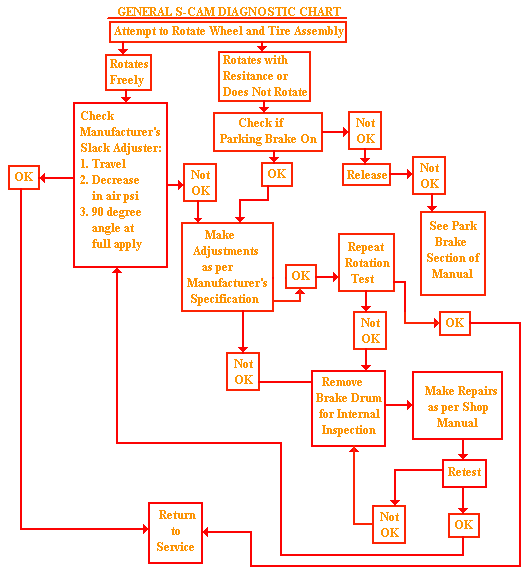
- INFORMATION CHECK
- Indicate whether the statements below are true or false. If false, please explain why it is false.
- 1._______ All S-CAM brakes must be periodically adjusted.
- 2._______ One important S-CAM brake adjustment check is to check to see that the pushrod and slack adjuster are at 90° to each other with maximum brake application.
- 3._______ As long as the wheel turns freely, no adjustment is needed on an S-CAM brake.
- 4._______ A properly adjusted S-CAM brake will typically drop the system air pressure 18 to 22 psi.
- 5._______ Which of these S-CAM brake problems will decrease mpg?
- A). Broken return spring
- B). Too little slack adjuster travel
- C). Worn or improperly lubricated backing plate
- D). A, B, or C
- TEACHER'S NOTES
- Excessively loose slack adjusters are dangerous. Students, in their zealousness to make sure the brakes respond rapidly, have a tendency to reduce travel to less than the minimum. As a result, the shoes drag, especially when the drums are expanded from braking induced heat gain. A slow releasing or non-releasing shoe will not only wear out faster but will reduce the vehicle's mpg. It is important that students realize that even though S-CAM brakes are adjusted properly, broken or worn return springs and/or a worn or non-lubricated backing plate can also cause S-CAM shoes to drag.
- ANSWERS TO INFORMATION CHECK
- 1. False. Some S-CAM brakes have automatic self adjusters. These do need to be checked periodically for shoe drag due to other failures.
- 2. True. Maximum force is generated when the slack adjuster and pushrod are at 90°.
- 3. False. There might be excessive clearance between the shoe and drum. This could result in delayed brake application or reduced force upon maximum application of the S-CAM brake.
- 4. False. Generally an 8 to 12 psi is the expected range. Always have student check the shop manual for the correct range for a given vehicle.
- 5. D. All of these are possible S-CAM brake drag problems.
- RECOMMENDED READING:
- On Highway Trucks, pages 549-554.
- Diesel Equipment I, pages 250-259
- REFERENCES:
- Brady, Robert N. On-Highway Trucks. Reston Publishing Co. Inc., Reston, VA. 1982.
- Schulz, Erich J. Diesel Equipment I. Gregg Division of McGraw Hill, New York. 1982.
Comments or questions to: TechAsmt@LA.GOV
Return to Diesel Menu








